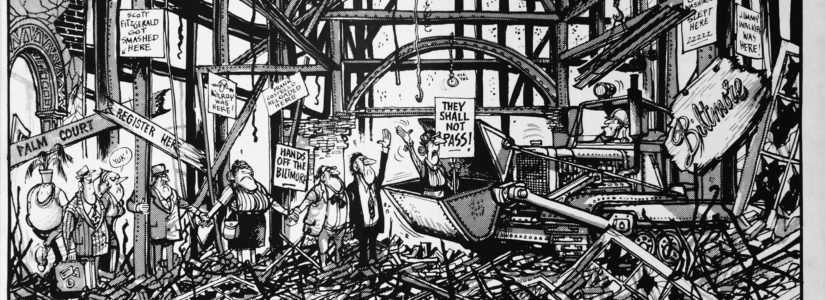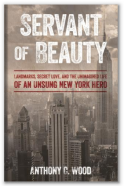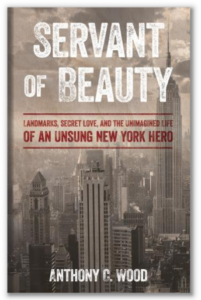
How Soon We Forget
May 20, 2015 | by Anthony C. Wood, Founder & Chair
Article from the Spring 2015 Newsletter
I confess. The rumor is true. I was thrown out of the Biltmore Hotel in August of 1981. I was not shown the door for the type of misbehavior that usually gets one booted from such a grand venue. In fact I was in particularly good company when I was ejected. Gabe Pressman, “one of the pioneers of United States television news,” (according to Wikipedia, so it must be true) and I were unsuccessfully trying to get a glimpse of the in-progress demolition of the Biltmore Hotel’s famed Palm Court. That did not sit well with those swinging the sledgehammers so out we went! In a place of honor in my office today is my souvenir of that episode: a 9″ strip of decorative plaster molding from the Biltmore.
The Friday, August 14, 1981 demolition of the Biltmore’s historic interior surprised New Yorkers, preservationists, and the New York City Landmarks Preservation Commission (which at the time was considering several of the hotel’s interiors for possible designation as interior landmarks). Last minute legal action was too last minute. When the sorry story came to its ultimate conclusion, the Palm Court and a number of other significant interiors were destroyed. The Biltmore would be re-clad and become unrecognizable inside and out. The main villains in this piece were the Bank of America and Seymour and Paul Milstein. After the building was refaced, Paul Goldberger would describe it as “a bloated, heavy form of glass and polished granite, unrelieved by any of the gracious ornament that made the old Biltmore so beloved a presence.”
Having been involved in the failed last minute efforts to prevent the wreck of the Biltmore on that Friday and over that August weekend, I vowed never to go into the building again. Fast forward to September 30, 2014. I am headed to a noon board meeting of the New York Preservation Archive Project. A board member generously volunteered a conference room at his new law firm. The address: 335 Madison Avenue. We are promised glorious views over Grand Central Terminal. When entering the information in my calendar, I didn’t give it a second thought. Later I realized I should have been tipped off by the comment about the views.
The day of the meeting, I exit Grand Central and walk across Vanderbilt Avenue heading towards Madison. I think to myself, “Where exactly is 335?” It then struck me that 335 Madison had to be the site of the old Biltmore Hotel. Because the Biltmore was such a New York icon, no one ever used its street address. You would just tell a cabbie “Take me to the Biltmore.” If you were meeting someone there, it would just be “meet me under the clock.” So, in fact, I had not forgotten the address of the Biltmore, I never knew it. Nor had I forgotten my vow not to enter the building. Pausing a moment to consider whether it was even an option to boycott the board meeting of my own organization that I am chairing, I sucked it up and after 33 years, entered the Biltmore and the new space that had replaced the Palm Court.
Well, I certainly had not missed anything over those three plus decades. For this the Biltmore interiors had been sacrificed? As a bone tossed to preservationists (well actually only a fragment of a bone), the famed Biltmore Clock had been re-installed in the building’s modern lobby. It is so dwarfed and looks so ridiculously out of place that when I saw it I could not believe this was their gesture to preservation that I had read about years ago.
In light of this, I had to start the board meeting with the subject of the Biltmore and my broken vow. Some longtime New York board members had vague recollections of the battle over the Biltmore. Younger board members had not forgotten the battle, they had never heard of it. And how would they? That, of course, is my point.
Unless such chapters in preservation history are captured and brought to the fore, how are new generations of preservationists to know “their” preservation history? We must be thankful that at least the highpoints (or should I say low points?) of the Biltmore story are captured for the record within Stern, Fishman, and Tilove’s 1,520 page New York 2000: Architecture and Urbanism between the Bicentennial and the Millennium. However the Biltmore preservation story, like so many others, deserves fuller attention and certainly broader recognition.
Why is it important to remember the battle over the Biltmore? First, it gives one a sense of what preservation in New York City was like in the early 1980s, just three years after the Penn Central decision. It is yet another cautionary tale—a reminder of the need for preservationists to get ahead of the wave, instead of having it crash over their heads. In this case, the need to landmark before it is too late. It is a reminder of the often plodding nature of the official landmark process. It explains why August in New York is still greeted with dread by some preservationists, who see it as a time for hyper vigilance, not relaxation. It demonstrates the necessity of going into court for restraining orders and the need to have that legal skill set finally honed.
Perhaps most importantly, the loss of the Biltmore is instructive in the dangerous game of making private preservation deals with developers. After demolition was well underway, the New York Landmarks Conservancy, supported by the Municipal Art Society, struck a deal with the Milsteins to “restore” the Palm Court if the Landmarks Preservation Commission did not move to designate the exterior, the ballroom, or the lobby—all then under consideration. No designations took place yet today there is no Palm Court. Ultimately with a $500,000 contribution to the Conservancy the developers got out of their agreement. Robert A.M. Stern et al. in New York 2000 describe this payment as “an unsettling offer that amounted to little more than blood money.”
Yes, episodes in preservation history such as the loss of the Biltmore—largely forgotten today—have their instructive value. One may disagree on exactly what these lessons are, but they are there. The knowledge of such preservation stories provide insight into the past, help explain present attitudes among at least one generation of preservationists, and by example, suggest what not to do and what can be done better as we move towards the future. Indeed, the current, appropriately intense focus on the 50th Anniversary of the Landmarks Law—the first 50 years of its implementation, and the last century of preservation in New York—is not underway to pat ourselves on the back or kick ourselves in the backside, but rather to document, preserve, and celebrate our history, the key repository of some of our most valuable intellectual capital, and use it to “up our game” as we enter the next half century of preservation.
One upside of breaking my vow never to enter that building was the realization that in avoiding 335 Madison Avenue for 33 years I had missed nothing. That too is useful knowledge as I contemplate a future likely to include an ever-expanding list of buildings I will need to be boycotting. That list could be a lot shorter if preservationists remembered their past and put it to good use.
The memory of the loss of Pennsylvania Station still helps fuel the preservation movement—in New York City and around the world. It continues to inform, instruct, and inspire today’s preservation movement. So too could the stories of the battle for the Biltmore, or, for that matter, the battle for the Dvŏŕak House, or Lüchow’s, or the Purchase Building, or Dorothy Day’s Bungalow in Spanish Camp, or Billy Rose’s Aquacade, or the Coogan Building, or the Goelet Garage, or 2 Columbus Circle, and the list of losses goes on. However we do so, these stories must be documented and preserved.
On this golden jubilee of the Landmarks Law, ask yourself: “Have you done your part to preserve the history of preservation that you helped make—both triumphs and tragedies?” If not, now is the perfect time to start.
Long live the Biltmore!




